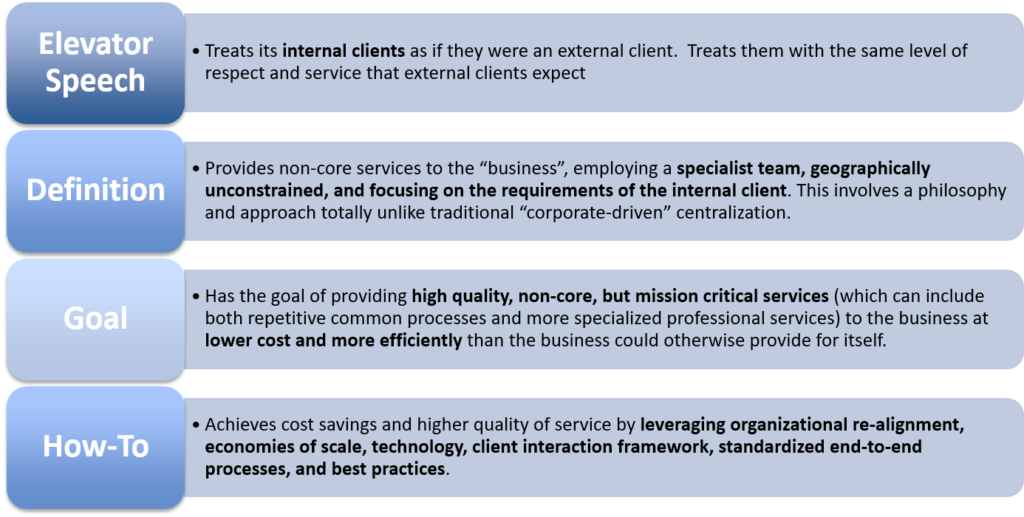What Is Shared Services?
“Shared Services” is a delivery model for the effective and efficient delivery of non-core services to the business, employing a specialist team, geographically unconstrained, and focusing on the requirements of the customer. This involves philosophy and approach totally unlike traditional Corporate-driven centralization.
It is characterized by its client-focus, use of technology, and implementation of leading practices. It operates as a business in that it seeks to provide services to its clients (rather than treating volume as workload to be avoided), the costs of these services are known, and it strives for continuous improvement.
The goal of Shared Services is to provide high quality, non-core, but mission-critical, services (which can include both repetitive common processes and more specialized professional services) to the business at a lower cost and more efficiently than the business could otherwise provide for itself.
Developing a Shared Services Business Case
It is critical to have strong senior executive support for any shared services initiative, although there is a risk when they tell their teams “to get on with it” because the opportunity is a “no-brainer”. Your senior executive lead can change and if you do not have a business case, your mandate may leave at the same time. The business case helps protect you from changes at the top and provides a vehicle to achieve executive buy-in.
So, what is a business case? At its most basic level, the business case describes a problem and proposes a solution. The solution will require a commitment of resources, so the business case justifies this business decision by outlining the change rationale and providing the costs and benefits. Most business cases will provide this, but a leading practice business case will do more than provide a target for savings; it will provide a blueprint for the solution.
Shared Services Benefits
Shared Services is an operating model and approach which, if implemented properly, has tremendous potential for an organization to obtain a “triple benefit”:
- Enabling greater efficiency and cost savings
- Providing improved visibility, transparency and control, reducing acknowledged waste such as significant improper payments
- Improving the quality of service by leveraging organizational re-alignment, technology, client interaction framework, standardized end-to-end processes, and best practices.
When Is Shared Services Not Really Shared Services?
This may seem like an obvious answer, but the question is a critical one when looking at shared services and what happens when a shared services operation is in danger of failing or has in fact already failed.
Not every shared service implementation will be a success but, there are degrees of success and some examples are better than others. What is important, therefore, is understanding what characterises a poor implementation, and what are the signs that you should look out for to prevent or diagnose a failing shared services operation.
Download our article on when is shared services not really shared services to learn more.
Getting the Basics Right
Over the years, many of the conversations we have had with Shared Services (SS) practitioners are about still getting the basics right, despite the fact that the shared services model is maturing and evolving rapidly, for example with the expanded use of digital and intelligent automation technologies, such as Robotic Process Automation.
Some of the root causes of Shared Services not performing as planned often relate to: weak performance measurement, a lack of end-to-end process documentation, and a deficient Client Interaction/Service Delivery Framework.
Here are some of our experiences and recommendations on how to make sure you get the basics right for your Shared Services operation.














